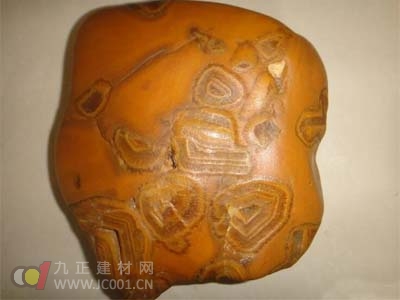Yellow Wax Stone: True and False Identification Tips: Yellow wax stone, also known as "Dragon King Jade," gets its name from the waxy texture on its surface. Some believe it originates from a region known for wax, hence the name. This stone is typically a silicified andesite or sandstone, primarily composed of quartz. Its waxy, oily surface is formed by a low-temperature melt, giving it a hardness of 6.5 to 7.5 on the Mohs scale.
Due to its similar color, texture, and hardness to natural yellow jade (often referred to as "yellow enamel"), many consumers and even some jewelers initially mistook yellow wax stone for real yellow jade. In some cases, inspection departments also made errors in identification. However, there are clear differences that can be used for non-destructive testing, such as mineral particle size, density, refractive index, polished surface texture, and the distribution of limonite under a high-magnification loupe.

Examining the graininess and polished surface: High-quality yellow wax stone is mainly composed of opal or chalcedony, with mineral particles smaller than 0.01 mm, making them invisible to the naked eye. In contrast, yellow jade (or "Huanglongyu") contains sodium-aluminum minerals, with larger particles visible to the eye. These particles may show optical effects like green spots or cloudiness, which are not present in genuine yellow wax stone. The polished surface of authentic yellow wax stone appears smooth without micro-ripples or greenish specks.
Weight comparison: The density of yellow wax stone is around 2.60, while yellow jade has a higher density of approximately 3.33. This means that, for the same size, yellow wax stone feels significantly lighter in hand compared to real yellow jade.
Refractive index measurement: The refractive index of yellow wax stone is about 1.54, whereas that of yellow jade is around 1.66. This difference affects the light reflection and gloss, making yellow wax stone appear less lustrous than true yellow jade.
Limonite distribution under magnification: Under a high-powered magnifier, yellow wax stone shows uniformly dispersed, yellow-brown colloidal limonite within amorphous opal or cryptocrystalline chalcedony, without any network-like pattern. In contrast, yellow jade contains limonite that fills the intercrystalline spaces of fine-grained sodium-aluminum minerals, creating a distinct network distribution.
LED Fountain Light
6W,9W,12W,24W LED Underwater Fountain Light,High quality world class brand LED chips and driver,304 stainless steel housing support Fountain Lighting show.Singel color and DMX512 RGB color for select.Install in Park fountian,Lake,Hotel Fountain.
Products Description:
1,Satinless steel and strick manufacturing process technology,low voltage high safety.
2,Use Cree,brigelux,Osram chips and stable driver,Longlife span.3-5 years warranty quality.
3.Control system:Singel control,DMX512 control.

Our other products range:LED Underground Light, LED Underwater Light , LED Wall Washer Light, LED Linear Light , LED Outdoor Flood Light, LED Garden Light , LED landscape light , LED Strip Light , LED Step Light etc.
Underwater Fountain Light,Fountain Light show,Light in Fountain,Fountain Landscape.Yard Fountian Light
SHENGYA LIGHTING TECHNOLOGY CO., LTD. , https://www.syalighting.com